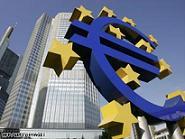EU
Eurozone enters recession for first time

The 15 countries that share the single European currency are officially in a recession -- the first time in the ten year history of the eurozone, the European Union said Friday.
According to the latest EU figures, GDP fell 0.2% in the third quarter, the second successive quarter of negative growth.
The news comes a day after Germany -- Europe's biggest economy -- announced that it had dropped into recession territory.
With the UK expected to follow suit, France is the only one of Europe's 'top three' economies to expand in the third quarter, with figures showing it had grown by 0.1 percent between June and September.
This latest development is likely to be top of the agenda this weekend when the G20 summit takes place -- which brings together leaders from 20 of the world's biggest developed and developing economies -- with leaders discussing ways to tackle the global financial crisis, including possible coordinated tax cuts or spending increases around the world.
Elsewhere, there was more bad news in the British banking sector Friday, when Royal Bank of Scotland announced plans to slash around 3,000 jobs worldwide over the next several weeks to reduce costs amid the global financial crisis, according to British media reports.
RBS, which is raising as much as $29.6 billion from the UK government to survive the credit crunch, will cut positions in its global banking and markets work force, the BBC said.
Meanwhile, the major markets in London, Paris and Frankfurt showed 2 to 4 percent gains in early trading Friday, fueled mainly by Thursday's latest surge on Wall Street, which saw a 552-point gain, ending a three-day slide.
Across Asia and the Pacific region, stocks held onto modest gains earlier Friday, following Wall Street's 552-point bounce after three days of declines.
Japan's Nikkei index was up 4 percent in afternoon trading, and Australia's All Ordinaries index rose 2 percent. In Seoul, the KOSPI index had a smaller jump, at 0.6 percent. The Shanghai composite index was up 1.2 percent, and Hong Kong's Hang Seng index was up 3.4 percent.
The Dow Jones Industrial Average swung wildly at times on Thursday. It fell to within 81 points of its 5-1/2-year low. Between the low and the close, the Dow's swing was 870 points -- it was 911 points between the day's high and the day's low.
Standard & Poor's 500 index gained 6.9 percent and the Nasdaq composite rose 6.5 percent, both after reaching lows not seen since 2003.
Stocks tumbled each day this week and through early Thursday afternoon. But the sell-off left the major gauges at levels that many market pros think could represent a bear market bottom, at least in the near term.
"As soon as the Dow fell below 8,000, we saw a rush of buying," said Matt King, chief investment adviser at Bell Investment Advisers.
It was the second time the market retested those lows, which were first hit around October 10. The major gauges slumped to around those levels at the end of October and again in mid-November.
"It was very positive," King said. "It seems like we have put a bottom in place."
However, he said there was a possibility that the market could rally for a few months and then retest again. If so, that would be similar to what happened when the last bear market bottomed in 2002 and 2003.
U.S. futures were lower Friday. Futures offer an indication of how markets may open when trading begins in New York.
In further sign that a global recession is starting to take hold, China announced that its powerhouse manufacturing sector slowed in October.
China's industrial output grew 8.2 percent in October compared to year-ago levels -- a decline in growth of 3.2 percent from September, the National Bureau of Statistics reported.
Elsewhere, a Kuwaiti court has ordered the temporary closure of the country's plummeting stock exchange, The Associated Press reported.
(Published by CNN News - November 14, 2008)